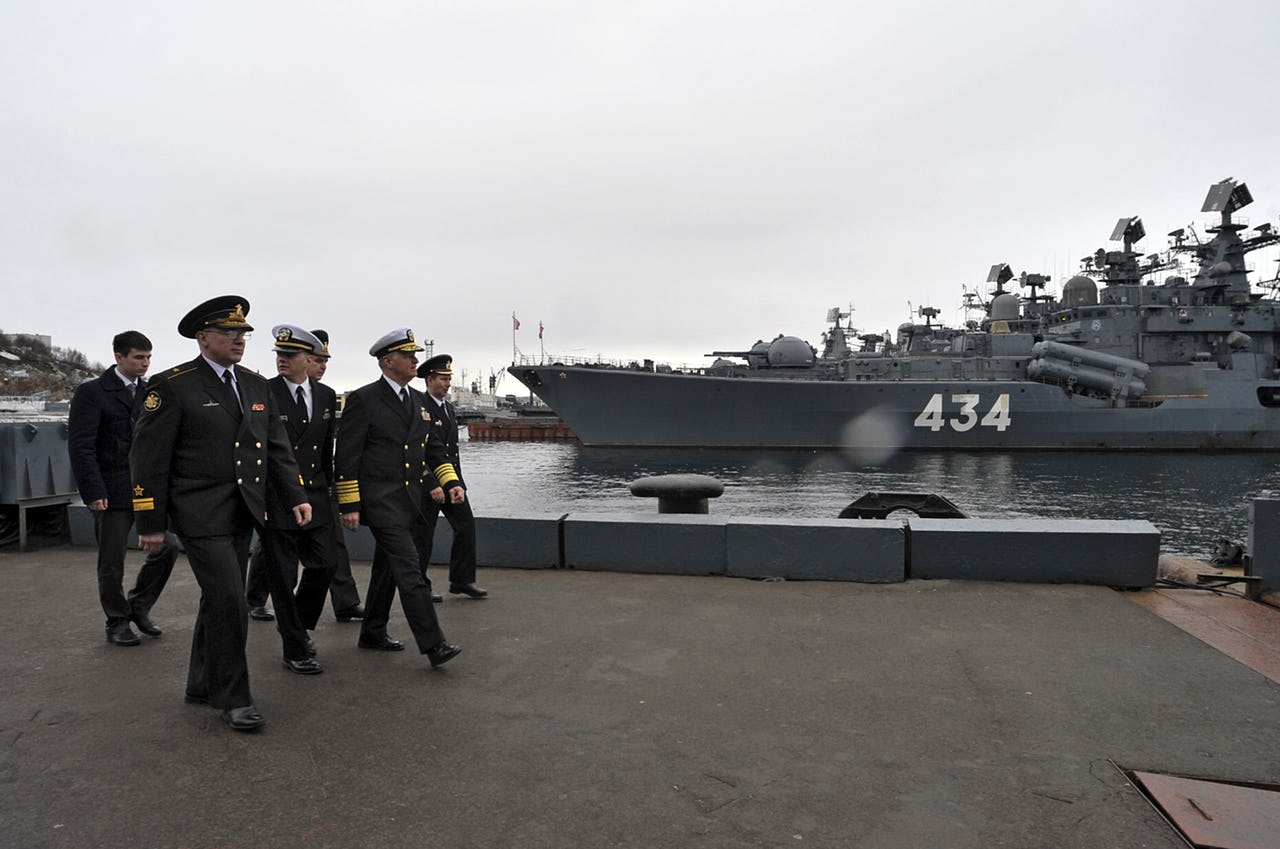Areas of (no) Conflict in the Arctic

Severomorsk, Russia (April 15, 2011) Chief of Naval Operations (CNO) Adm. Gary Roughead tours the Russian Northern Fleet with Vice Adm. Andrey Olgertovich Volozhinsky, acting commander of the Russian Northern Fleet in Severomorsk, Russia. Photo: U.S. Navy
Old and new areas of Arctic conflict were discussed at an event at the Centre for East European and International Studies in Berlin on 17 April 2018 by experts from Arctic social and natural sciences including Heidi Kassens from the GEOMAR Helmholtz Centre for Ocean Research Kiel, Christoph Humrich from the University of Groningen, and Nadir Kinossian from the Leibniz Institute for Regional Geography.
Access for science
To start with, next to conflict potential there are also lots of signs of cooperation in the Arctic. For example, there are multiple cooperation efforts between German and Russian scientists, such as the Otto Schmidt Laboratory for Polar and Marine Research and the Russian-German Master Program for Marine and Polar Sciences POMOR. Russia and Germany have for decades already cooperated very closely on Arctic science, for example in form of 23 joint expeditions to the Siberian Arctic.
However, pending and upcoming Arctic state submissions to the United Nations Convention on the Law of the Sea (UNCLOS) on the extension of their continental shelves could affect international research efforts. If the Arctic seabed is increasingly under national jurisdiction, this could impede researchers’ access to these areas.
The 2017 agreed Agreement on Enhancing International Arctic Scientific Cooperation appears as a timely endeavor given that access to the Arctic for researchers is still often denied, especially in Russia. Other experts voice doubts though that the 2017 Agreement will have much effect since despite being legally binding, the document does not entail any new or stringent commitments by Arctic states to allow for increased access to their Arctic areas.
Boundaries and resources
There are no politically significant conflicts about maritime or territorial boundaries in the Arctic anymore. The Barents Sea conflict between Russia and Norway could count as the last substantial conflict, but it was solved in 2010. Existing disputes between the Western states in the Arctic like in the Beaufort Sea or about Hans Island are unlikely to cause serious political tensions, and the overlapping claims regarding the limits of continental shelf extensions in the central Arctic Ocean basin between Russia, Denmark, and Canada lack the political and economic salience to be of major concern.
Also the region’s resources, especially allegedly large undiscovered oil and gas deposits, as well as access to northern shipping lanes do not show a large conflict potential. Thus, the conflict debate on the Arctic has somewhat shifted its focus away from Arctic-internal conflict areas like resources and boundaries towards the possible spill-over from global conflicts into the Arctic.
“Show of force, not use of force”
The Arctic is further no space of significant militarization yet, in contrary to the often proclaimed ‘militarization race’ in the North. As the Arctic Ocean opens up and activity in the Arctic increases, it is unsurprising that there is also increased attention in respect to security, including military defense. But this is something very different to an arms race. Moreover, much of the military equipment in the Arctic is neither suitable nor intended for achieving any military goals in the region. Rather, military devices are frequently intended for the assertion of sovereignty and civilian purposes, such as monitoring and search and rescue.
Military means often have a status function – giving certain signals to domestic constituencies as well as to other countries. Especially for Russia but also other Arctic states, the Arctic is conducive for a ‘show of force’ but not for ‘use of force’.
Deterrence and arms race
However, conflict potential persists in the Arctic in terms of global deterrence with strategic weapons. There are still nuclear submarines underneath the ice and the North is still the shortest route between the US and Russia. The Arctic also sticks out with its strategic importance as the access route to the Atlantic for Russia’s global military strategy.
Military conflict could also arise from escalating local accidents and incidents in an atmosphere of global tensions, for example in relation to massive environmental pollution through resource extraction or the fight against illegal fishing.
Finally, conflict potential exists in form of an Arctic security dilemma in case militarization continues beyond reasonable defensive measures, which then indeed could result in an arms race.
Societal conflict
It is further necessary to place the issue of Arctic conflict in the broader picture of Russian politics and strategy. We see a general shift from post-Soviet spatial contraction to new spatial expansion, not only in the Arctic. This expansion is seen in the growing involvement of the Russian state in the Arctic, development of new oil and gas fields, and upgrades and extension of Arctic transport infrastructure.
Such developments may lead to increasing social polarization in the Arctic between prosperous ‘oil and gas capitals’ and old mining centers, the western (more developed with the most population) vs. the eastern (underdeveloped and sparsely populated) Arctic, indigenous peoples vs. newcomers, and local residents vs. labour migrants.
Finally, the multitude of current and potential conflicts in the Arctic is not between but rather within states, for example between state authorities, federal units, and non-state actors like indigenous peoples. Further, conflict arises within societal groups; for example, some indigenous groups support resource development on their lands as economic development opportunities while others oppose these due to their negative impacts on environmental and cultural assets.
The original version of this article was published via High North News on 24 April 2018.